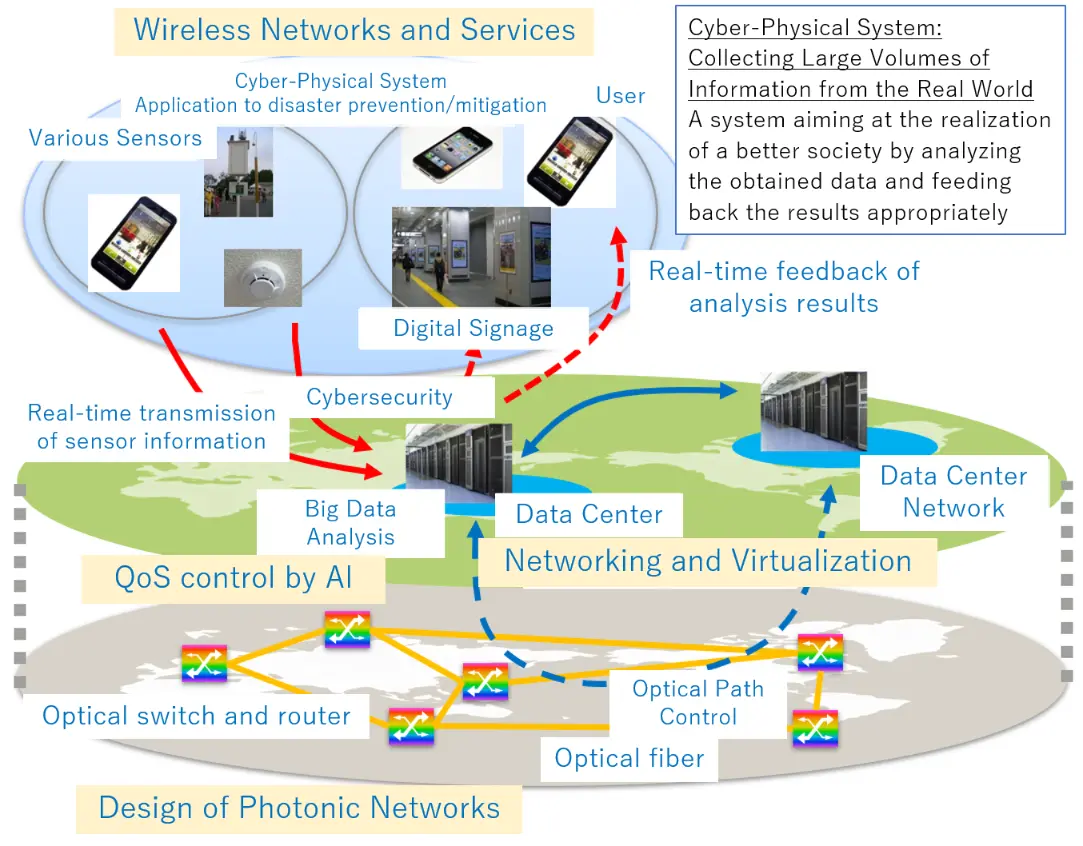
In recent years, in addition to the widespread use of smartphones and tablet PCs, home appliances such as TVs have become connected to the Internet. As a result of this diversification of network-based services, the amount of information flowing through the network is increasing. In order to transfer these various services and vast amounts of information, we are researching the design of new networks, mainly wireless and photonic networks, and the efficient and reliable use of existing networks.
-keyword- Optical Network, Cloud, Data Center, Smartphone, Cyberphysical
The research topics covered in this laboratory are classified into three main themes: access network, middleware network design, and core network.
The following is an introduction to the research topic.
In the access network, we mainly conduct research on wireless communication and sensor networks in the network for accessing the core network from user terminals. The research topics covered in this laboratory include emergency voice communications reception control , Ad-hoc networks , and ensor networks.
In an emergency such as an earthquake or fire, a large number of calls are made to the affected area or the area around the site to confirm the safety of the victim, to report the safety of the victim from the affected area, or to make emergency calls to the police or fire department. This causes congestion in the local circuit-switched network and makes it difficult to connect. In this situation, we are doing research to accommodate as many call requests as possible while maintaining voice quality.
Our research focuses mainly on controlling the reception of calls in IP telephone networks, controlling the bandwidth used, and switching codecs.
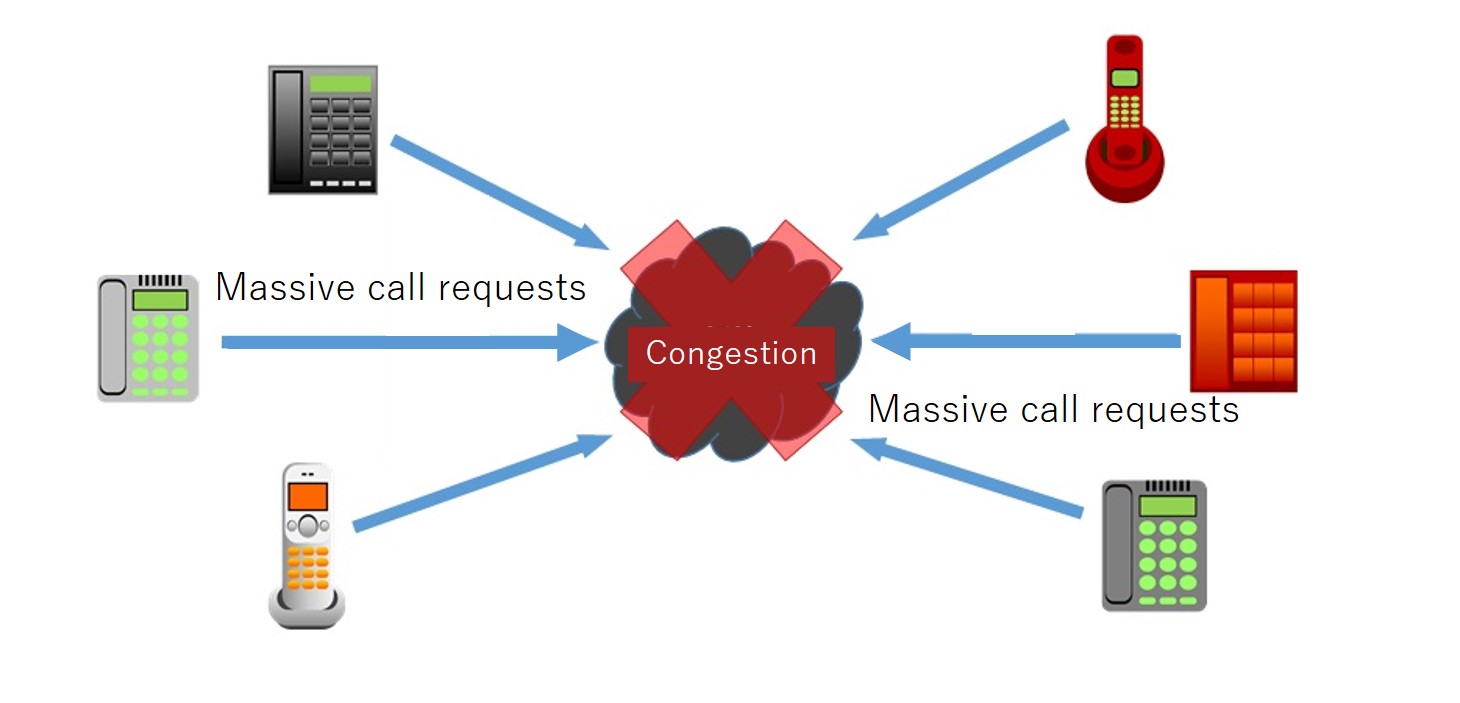
-keyword- emergency communications, bandwidth control, voice codec, VoIP
Ad-hoc networks allow terminals to form networks without the need for base stations or access points, enabling communication even in places where network infrastructure cannot be installed. Conventional ad hoc networks are designed for the use of non-directional antennas (beams radiating in the direction of 360 °) in data communication. However, as a disadvantage, there is a problem that radio wave interference in the direction not to communicate and the number of terminals whose communication is limited by the interference increase, and space use efficiency decreases. Therefore, by using a directional antenna capable of emitting a beam only in the direction desired for communication, interference with neighboring terminals is reduced, and the number of terminals subject to communication restriction is reduced, thereby improving space use efficiency.
Our laboratory is conducting research to reduce link disconnection and improve space utilization efficiency in the directional communication of ad hoc networks.

-keyword- Ad-hoc networks, directional antennas, wireless communications
A sensor network is a system in which a large number of wireless sensors are placed and information is obtained from the sensors. For example, if you are outdoors, GPS. If you are indoors, controllers, smart homes, and so on are also classified in this sensor network. In our research, we mainly study location estimation. There are many modern wireless technologies. Examples include wireless LAN (Wi-Fi) and BLE (Bluetooth Low Energy). We conduct research using such various wireless technologies.
Our laboratory deals mainly with BLE. We use beacons called BLE beacons to estimate locations in indoor environments where radio waves such as walls are shielded.
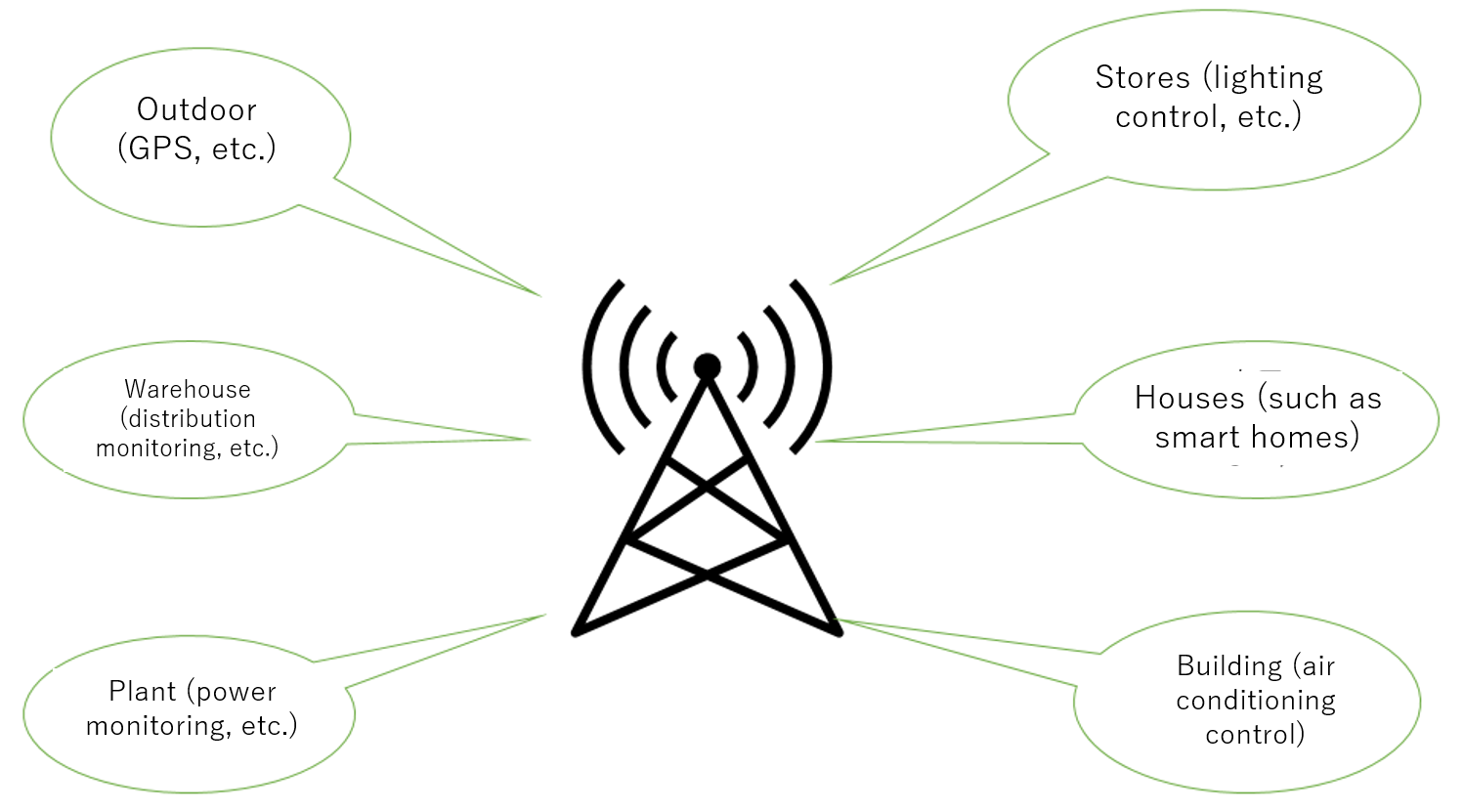
-keyword- GPS, location estimation, control device
Middleware network design studies the design and control of networks between user terminals and servers. Research topics covered in this laboratory include network and server virtualization technologies, network security, data center networks, and high-speed transfer protocols.
Recently, network services have diversified due to the spread of smartphones and information appliances. In order to provide these various network services, an apparatus for implementing network functions is required.
However, conventionally, when a new user joins or requests the addition of a network function, it is necessary to procure or deploy a dedicated device that differs for each function, resulting in an increase in equipment and operation costs.
Therefore, a network function virtualization (NFV) which implements a plurality of network functions as a virtual machine (VM) on a general purpose server using a server virtualization technology instead of a dedicated device is being studied. NFV is a system that implements functions of network communication equipment as software and executes them on the OS of a virtualized server. As a result, it is possible to reduce equipment and operation costs, increase or decrease the number of VMs and allocate resources according to the utilization status of functions and load.
In our laboratory, we have been conducting research on SDN, which uses NFV and software to centrally control routes in networks. We are mainly conducting research on “service chaining ”, which provides multiple network functions as a single service for each user using NFV and SDN, and resource allocation and routing methods according to network service requirements.
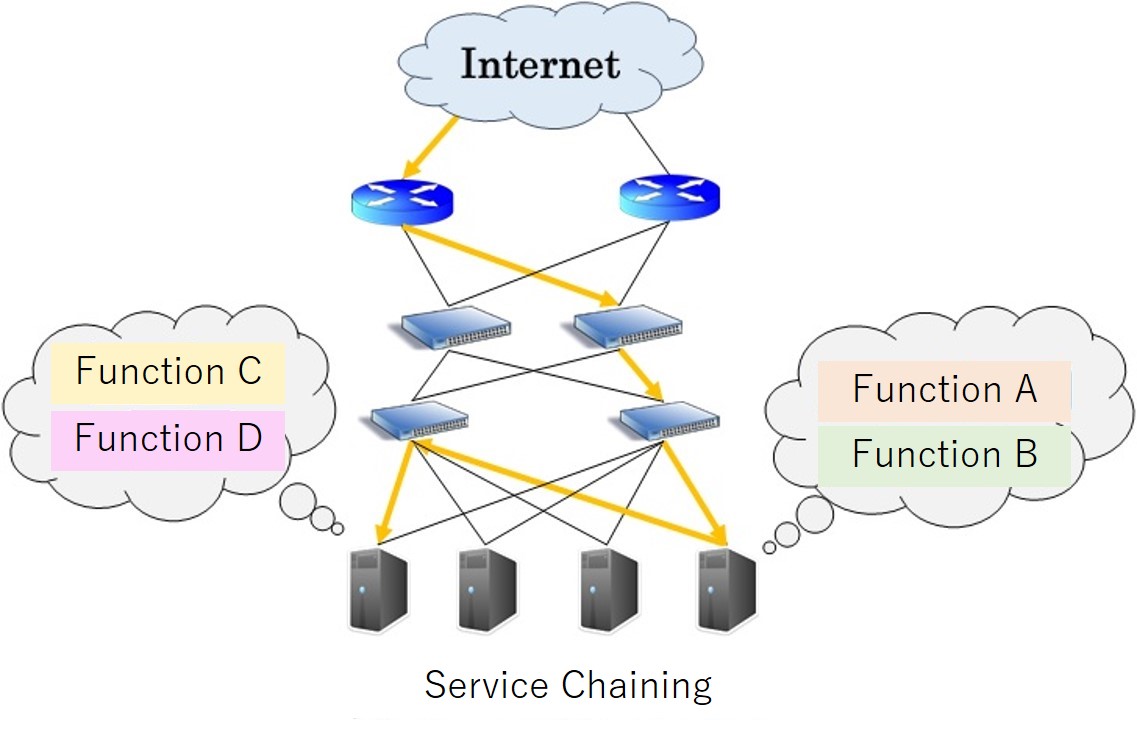
-keyword- server virtualization, NFV, SDN, service chaining
With the spread of the Internet, the Internet has become indispensable for exchanging various kinds of information. In this environment, there are security threats such as systems being shut down or sensitive information being stolen by malicious users.
Our lab is studying security techniques to combat these attacks.
Attacks vary widely and evolve daily, so you need to know the characteristics of an attack to be able to respond to them.
The communication of unknown attack is included in the communication we usually receive. Therefore, by analyzing these communications and understanding the characteristics of unknown attacks, it is possible to sort the communications that appear to be attacks and prevent them from being attacked, and to precisely control the network and prevent infection from spreading to other terminals.
We are working to create an environment that can detect such attacks and communicate securely.
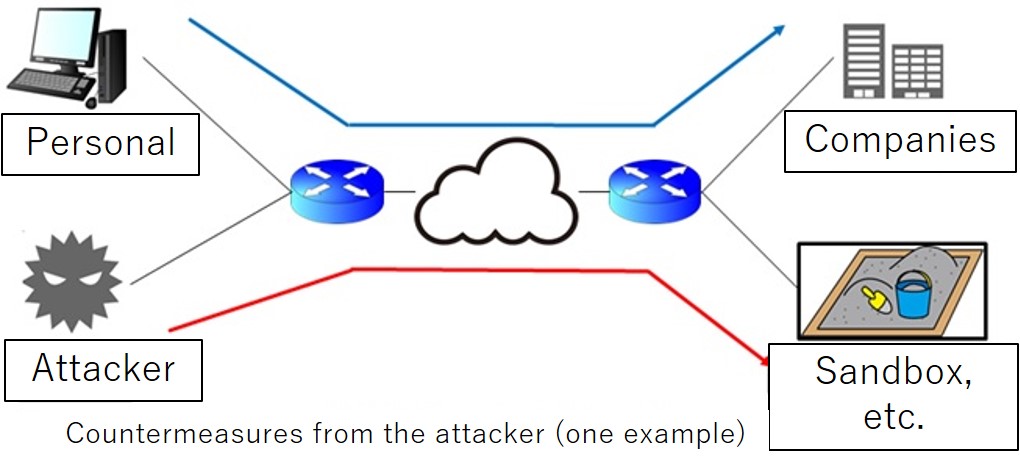
-keyword- security, network control, SDN, honeypot, attack prediction, unreached IP
In recent years, as cloud services have expanded, the number of data center installations has increased, services have diversified, and power consumption has also increased.
A data center consists of a group of servers and a network that connects them. The servers are housed in racks, and each server is connected to each other by a Top of Rack (ToR) switch. In a conventional data center network, communication is performed by an electric packet switch. However, in the communication by the electric packet switch, there are problems such as increased power consumption and inability to meet QoS (quality of service). Therefore, by using an optical switch that can perform optical communication called Optical Circuit Switching (OCS), power consumption can be reduced and high-speed communication can be performed.
Our laboratory is conducting research on the reduction of call loss and power consumption due to traffic concentration in data center networks using optical communications.
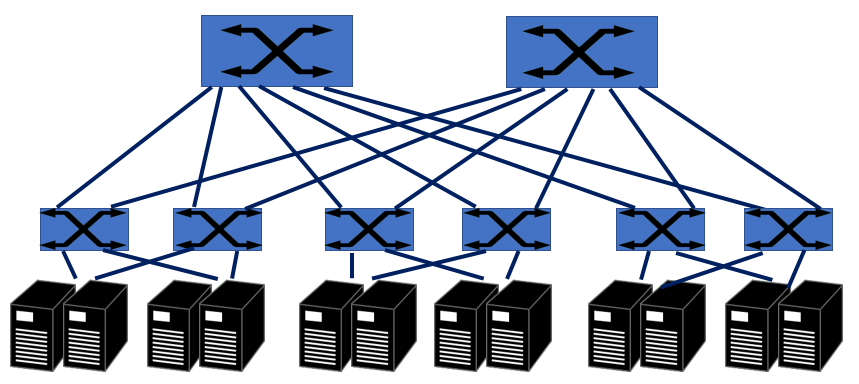
-keyword- data center network, OCS, fat tree
In the core network, we will conduct research on the construction and control of a new network using optical communication technology in a backbone network that transmits large amounts of data. Our research topic is Elastic Optical Network.
In an optical backbone network, an optical path is set from a source node to a destination node by an optical circuit switching method in order to carry out traffic transmission. In the conventional WDM network, an optical frequency spectrum arranged at a fixed grid interval (such as 100 GHz or 50 GHz) as shown in ITU-T G.694.1 is allocated to the optical path by a wavelength division multiplexing method. Since a fixed band is allocated to all optical path setting requests, the same band is allocated to optical path setting requests that use only a small band, resulting in a band that is not used substantially.
In recent years, Internet traffic has continued to increase due to the spread of high-speed broadband and the growing demand for video streaming. To accommodate such ever-increasing traffic, it is necessary to make more efficient use of limited optical frequency spectrum resources and to realize a larger transmission capacity.
Therefore, elastic optical networks are now attracting attention.
In an elastic optical network, the grid spacing of the optical frequency spectrum is made fine, and the optical OFDM (orthogonal frequency-division multiplexing) technology is used, so that the optical frequency spectrum resource can be allocated to the optical path by the required amount. Thus, the optical frequency spectrum utilization efficiency can be improved. Furthermore, since an optimal modulation method is assigned to the optical path according to the communication quality of each optical path, more optical frequency spectrum resources can be saved.
In an elastic optical network, the bandwidth allocation can be realized more flexibly and efficiently than in a WDM network, since the necessary amount of optical frequency spectrum resources is allocated using an optimal modulation scheme.
In this laboratory, we are researching how to assign optical paths to the optical frequency spectrum in an elastic optical network.

-Keyword- Elastic optical network, lightpath settings, lightpath division, RSA, RMLSA

Staff: server
Birth in Dec.
Research interests: Optical networks
Hobbies: Traveling and playing games
Comment: I will do my best!

Staff: Leader
Birth in June
Research interests: Optical networks
Hobbies: Watching soccer, watching movies
Comment: Aiming for a fulfilling research life

Staff: network
Birth in May
Research interests: Optical networks
Hobbies: Playing games and watching videos
Comment: Thank you!

Staff: chore
Birth in June
Research interests: Emergency voice communication reception control
Hobbies: Watching sports and listening to music
Comment: Job-hunting, working hard

Staff: server
Birth in Jan.
Research interests: Optical networks
Hobbies: Playing games
Comment: Thank you.

Staff: chore
Birth in May
Research interests: Access
Hobbies: Watching MLB games
Comment: Thank you.

Staff: Deputy Leader
Birth in May
Research interests:Core
Hobbies: Baseball
Comment: Let's do our best.

Staff: Deputy Leader
Birth in Apr.
Research interests:Acsess or Middleware
Hobbies: futsal
Comment: You can do it !

Staff: server
Birth in Mar.
Research interests: Congestion Control Algorithm
Hobbies: Manga, Web Master
Comment: I will enjoy doing research.

Staff: server
Birth in Nov.
Research interests: Middleware
Hobbies: action game
Comment: I want to stay well.

Staff: server
Birth in Sep.
Research interests: Core
Hobbies: game
Comment: I will work hard.

Staff: network
Birth in Feb.
Research interests: Middleware
Hobbies: game, watching esports
Comment: I would like to at least attend the meetings.

Staff: network
Birth in Jan.
Research interests: Middleware
Hobbies: makeup
Comment: Thank you

Staff: network
Birth in May
Research interests: Middleware
Hobbies: bicycle
Comment: I'll make efforts

Staff: chore
Birth in Jan.
Research interests: Middleware
Hobbies: Steam Library Completion (0% Progress)
Comment: Debugging life system

Staff: chore
Birth in Jun.
Research interests: Core
Hobbies: Minesweeper, No plan trip
Comment: I'm going to try to wake up early

Staff: chore
Birth in Feb.
Research interests: Core
Hobbies: Karaoke
Comment: Thank you, every one!

Staff: chore
Birth in Jun.
Research interests: Middleware
Hobbies: Strength training
Comment: Giant killing
etc.

22nd floor of Kogakuin University Shinjuku Campus
E-mail : contact[at]ans.cc.kogakuin.ac.jp
If you would like to visit the laboratory or learn about the laboratory, please contact me at the above address.